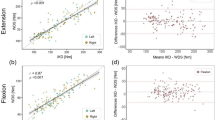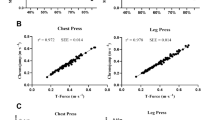Abstract
This study quantitatively assessed the mechanical reliability and validity of position, torque and velocity measurements of the Biodex System 3 isokinetic dynamometer. Trial-to-trial and day-to-day reliability were assessed during three trials on two separate days. To assess instrument validity, measurement of each variable using the Biodex System 3 dynamometer was compared to a criterion measure of position, torque and velocity. Position was assessed at 5° increments across the available range of motion of the dynamometer. Torque measures were assessed isometrically by hanging six different calibrated weights from the lever arm. Velocity was assessed (30°/s to 500°/s) across a 70° arc of motion by manually accelerating the weighted lever arm. With the exception of a systematic decrease in velocity at speeds of 300°/s and higher, the Biodex System 3 performed with acceptable mechanical reliability and validity on all variables tested.







Similar content being viewed by others

References
Bemben MG, Grump KJ, Massey BH (1988) Assessment of technical accuracy of the Cybex II isokinetic dynamometer and analog recording system. J Orthop Sports Phys Ther 10:12–17
Brown LE, Whitehurst M, Bryant JR, Buchalter DN (1993) Reliability of the Biodex System 2 isokinetic dynamometer concentric mode. Isokin Exerc Sci 3:106–163
Denegar CR, Ball DW (1993) Assessing reliability and precision of measurement: an introduction to intraclass correlation and standard error of measurement. J Sport Rehabil 2:35–42
Farrell M, Richards JG (1986) Analysis of the reliability and validity of the kinetic communicator exercise device. Med Sci Sports Exerc 18:44–49
Feiring DC, Ellenbecker TS, Dersheid GL (1990) Test-retest reliability of the Biodex isokinetic dynamometer. J Orthop Sports Phys Ther 11:298–300
Gleeson NP, Mercer TH (1996) The utility of isokinetic dynamometry in the assessment of human muscle function. Sports Med 21:18–34
Handel M, Dickhuth HH, Mayer F, Gulch RW (1996) Prerequisites and limitations to isokinetic measurements in humans: Investigations on a servomotor-controlled dynamometer. Eur J Appl Physiol 73:225–230
Iossifidou AN, Baltzopoulos V (2000) Inertial effects on moment development during isokinetic concentric knee extension testing. J Orthop Sports Phys Ther 30:317–327
Murray DA, Harrison E (1986) Constant velocity dynamometer: an appraisal using mechanical loading. Med Sci Sports Exerc 18:612–624
Patterson LA, Spivey WE (1992) Validity and reliability of the LIDO active isokinetic system. J Orthop Sports Phys Ther 15:32–36
Portney LG, Watkins MP (2000) Statistical measures of reliability. In: Foundations of clinical research: applications to practice, 2nd edn. Prentice Hall, New Jersey, pp 557–584
Sapega AA, Nicholas JA, Sokolow D, Saraniti A (1982) The nature of torque "overshoot" in Cybex isokinetic dynamometry. Med Sci Sports Exerc 14:368–375
Shrout PE, Fleiss JL (1979) Intraclass correlations: uses in assessing rater reliability. Psychol Bull 86:420–428
Taylor NAS, Sanders RH, Howick EI, Stanley SN (1991) Static and dynamic assessment of the Biodex dynamometer. Eur J Appl Physiol 62:180–188
Timm KE, Gennrich P, Burns R, Fyke D (1992) The mechanical and physiological performance reliability of selected isokinetic dynamometers. Isokin Exerc Sci 2:182–190
Author information
Authors and Affiliations
Corresponding author
Additional information
Disclosure
The Biodex dynamometer used for this investigation was donated to the laboratory by Biodex Medical Systems. The authors have no commercial or proprietary interest in this device.
Rights and permissions
About this article
Cite this article
Drouin, J.M., Valovich-mcLeod, T.C., Shultz, S.J. et al. Reliability and validity of the Biodex system 3 pro isokinetic dynamometer velocity, torque and position measurements. Eur J Appl Physiol 91, 22–29 (2004). https://doi.org/10.1007/s00421-003-0933-0
Accepted:
Published:
Issue Date:
DOI: https://doi.org/10.1007/s00421-003-0933-0



